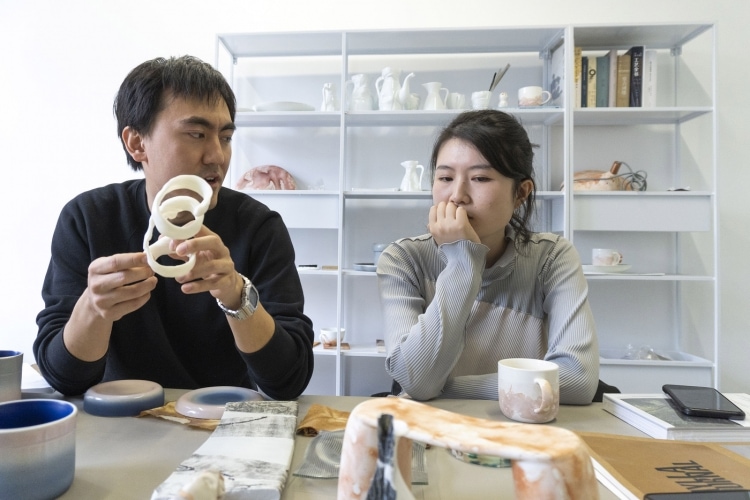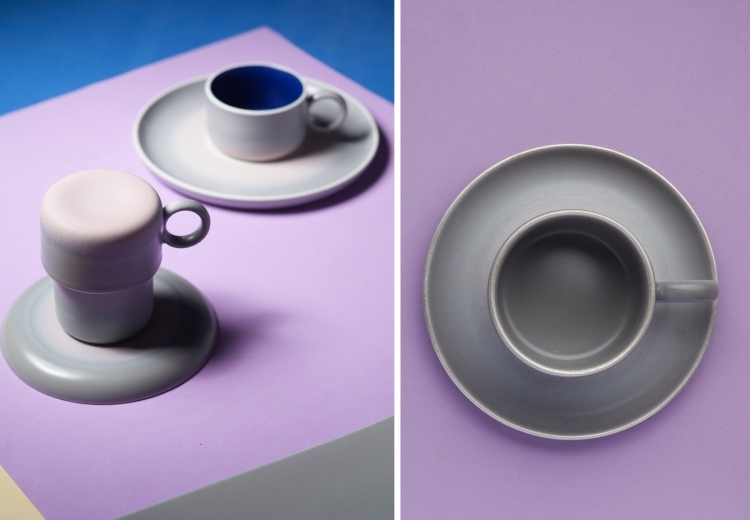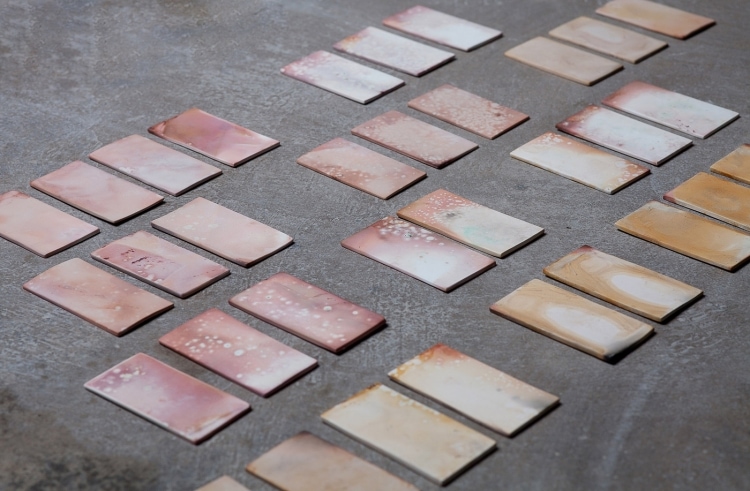Studio KAE and the new design generation
Last November, during the Design Shanghai fair, I met many interesting emergent designers and studios. In particular, I was fascinated by the products of a couple of very young Chinese designers, called Studio KAE. I decided to go to visit their space to know more about their work.
KAE is a young design consultation studio based in Shanghai founded by Zhekai Zhang and Keren Wang. They both graduated two years ago at the Royal College of Art in London with a major in Product Design and they specialized, respectively, in Ceramic Design and Interaction Design.
They were telling me how much the London experience influenced their design language and process. They decided, in fact, to leave China to find new inspirations and to enrich their vision and experience in order to combine the Chinese tradition about materials and manufacturing with the refined and well-established European design approach. They are aware that this is the only way to make the difference with their work, that is by discovering and learning disparate methods and systems and embracing an international breadth. To me the most interesting and relevant aspect of their work is the fact that they focus on innovative processes and materials. “The studio’s philosophy is to develop unique design languages from the perspective of the relationship between fundamental industrial production and craftsmanship”, they say.
The main material they have been working with, until now, is ceramic. The thing that has remarkably influenced this choice is their discovery of the infinite possibilities and expressions transferred to this material by the European culture, design, art and manufacturing. China has a long and deep tradition of ceramic’s making and the knowledge of both of the Chinese and the European expertise has represented a good potential to investigate and experiment in this field. After graduating, they came back to China and went to Jingdezhen, a city known as the "Porcelain Capital" because it has been producing Chinese ceramics for at least 1,000 years, and for much of that period Jingdezhen porcelain was the most important and finest quality in China. Here they could meet many craftsmen who helped them to realize their design. The very meaningful aspect of the projects created in Jingdezhen is the process itself, made of experiments, implementations or changes of techniques and making processes, original manufacturing solutions, everything in a dialogical collaboration with artisans and factories.
Studio KAE believes that innovation and new products can be inspired by an experimental process of materials manipulation and processing; they produce many original and experimental materials samples obtained through a mix of conventional and unusual techniques and then they translate them into new objects, functions, user experience and they start working on the industrialization and replicability.
In some cases, their collaboration translated in new line of products, design strategies and innovation for the factories. For example, the ceramic series “Lunar”, brings different layers of innovation, both on the shape, manufacturing, finishing and user experience sides. Designed together with a factory in Jingdezhen specialized in colouring techniques, “Lunar” is a set of tableware which “captures the colour of the lunar aureole through the colour glaze, expressing the praise of natural light and shadow.” They didn’t only focus on the sight, but they also created a gradient of different frosting tactile degrees, which, transitionally sprayed, overlapped with each other, forming a gradual change in tactile sense and gloss in addition to colour. Besides the finishing, that is the most evident feature, this product shows a high degree of design for usability and for manufacturability: the plate can be used to place things on both sides, also gets new ways to store and stack, which creates a freer user experience; the concave surface at the bottom of the utensil is a natural collapse due to the joint action of ceramic softening and self-weight under high-temperature firing, eventually leading to the arc surface. “Porcelain is by nature malleable, soft and warm. It’s only in the firing process that it gets rigid, hard and cool. Lunar expresses the true nature of the material.”
Another project is “Mistone”, a side table collection celebrating the beauty and diversity of marble. In this case, the innovation consists in the finishing process: “we used silver marble and applied an artificial sandblasting to incorporate a sense of irregular beauty into the marble texture; we recreated a natural transition from roughness to smoothness perceived by the touch.”
A very original project, in terms of manufacturing process and materials application, is “Fabric Formula NO.2”, a stool created with an unusual technique. This project explores the concept and features of the industrial mould as one of the symbols of mass production. Studio KAE created a new concept of mould realized with fabrics, where different textiles bring a unique beauty in the mass production system. The designers explored the possibility of different roles for traditional fabrics in mould production.
“Most of the traditional plastic chairs are injection moulded and then the surface is decorated with fabric, but Fabric Formula NO.2 changed this making process.”
The fabric itself, which is part of the final product, is at the same time the mould itself. It is filled, in fact, with a special low temperature melting plastic, Polymorph, which is boiled and then, cooling down, takes the final shape of the stool, thanks to the support of dynamic metal moulds.
“The contrast between the hard texture of the stool and the visual softness of the fabric surface creates an interesting sensory illusion.”
Another encounter between tradition and innovation happens in the “Coffire” lamps.
The innovative colouring technology used in Coffire was derived from the ancient pit burning technology, based on chemical reactions generated by a low-temperature firing process at 700-1000°C. Traditionally this technique uses different kind of organic materials to produce colouring effects, such as driftwood, seaweed, dried fruit skins, nut shells; studio KAE chooses to use coffee grounds, exploiting waste produced by the café industry, and to replace the traditional sandpits used in the pit burning process by gas kilns, which make it easier to control the reproducibility, the production and to improve the results. Under the influence of temperature, humidity, coffee grounds’ concentration, and other variables, the ceramics will show different pink random texture on the surface of the lamp, making each piece unique. Coffire lamp has a pink marble-like surface texture, which is a wonderful effect that no other glaze can achieve.
Another very delicate work is the “Layer-glazing” ceramics project which explores the potential of spraying slip and clay marbling and combine both techniques to create a new style of ceramic objects. This method consists in spraying coloured slips on the plaster mould to create marbling clay slabs. By using this technique, multiple layers of colours can be seen on the rim of the vase after assembling.
This project is also inspired by Xiang Qi, a unique Chinese traditional technique which is still in use in Jingdezhen. Using joint slip to attach bone-dry clay slabs together to make an object from 2D slabs to 3D forms. However, this unique traditional technique is less known in these days. This project aims to bring it back to people’s attention.
Studio KAE’s work is representative of some of the most interesting contemporary dynamics ongoing in the field of Design, such as the encounter between tradition and innovation and between distant and different cultures, the hybridization between industrial and artisanal, the mitigation of mass production with the uniqueness of products made possible by new manufacturing processes, the care for the environment and the quality of living and producing.

 English
English 日本語
日本語













